Our rocket workshops take many forms, subject to the needs of our work space, the type of projects we pursue, the time we have to work on our rockets, who shares our home, and all sorts of other factors--even what kind of pets we have! I think it would be helpful from time to time to post articles here in our How To section that give us a look at different club members' rocket workshops. Few of us have the space to dedicate to our hobby the way we would like to do. I always like to pick up ideas from other modelers, and often, the work space they have carved out gives us ideas for how we can organize our own space.

So I'll start out this mini-series in the How To section with a tour of my own work space, such as it is; it is shoehorned around kids' dress up and art supplies in the back of the TV room, but also hidden on shelves in the garage and in my closet. Like many Arizona homes, the lack of a basement puts a premium on storage space, and as you may have noticed, rockets can take up a lot of space! Yet I don't like to look at unfinished projects all the time, so I try to have a place set aside out of the way where I can leave projects to sit for a few days or weeks when I am busy on other things.

Primarily, I have a 6 foot by 2 foot folding table that I use for my low power projects--these days, mainly my competition models. Many of the boxes used in shipping rocketry supplies wind up being used as storage boxes for other supplies.
On shelves in the garage, I have a couple clear plastic hanging file tubs with various supplies in them. I have 8 or 10 in total, each storing items typically used together. Some hold small rockets ready for pre-flight check, while others hold small rockets in need of repair. One is dedicated to recovery supplies--parachutes, shock cords, streamers, etc. Another has nose cones and transitions. Another fin material of various sorts and sizes. Inside each bin, many items are stored in ziplock bags labeled clearly so I can grab just what I need easily. My kids are at an age where I like to be inside to keep an ear out during the time they may take to fall asleep, so I prefer to work inside. The clear plastic sides on the tubs mean I can walk out to the garage and pick the bin or two that I need, and bring them inside to work for the evening. And the bins stack nicely so the bins can stay out from under foot. A longstanding rule in our house is that model rockets are never left on the ground, where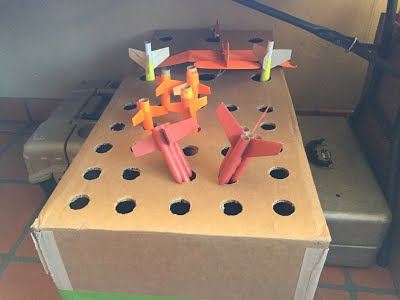 clumsy things like feet and dogs and other objects under the power of gravity tend to trample cardboard models. Delicate competition models proliferate, and I found a nice way to protect our competition models--punching holes in an old shipping box and storing models vertically under the table. Also tucked under there are separate tackle boxes and toolboxes for supplies, adhesives, and tools. Depending on the launch, I may take some or all of these tackle boxes along for the day.
clumsy things like feet and dogs and other objects under the power of gravity tend to trample cardboard models. Delicate competition models proliferate, and I found a nice way to protect our competition models--punching holes in an old shipping box and storing models vertically under the table. Also tucked under there are separate tackle boxes and toolboxes for supplies, adhesives, and tools. Depending on the launch, I may take some or all of these tackle boxes along for the day.
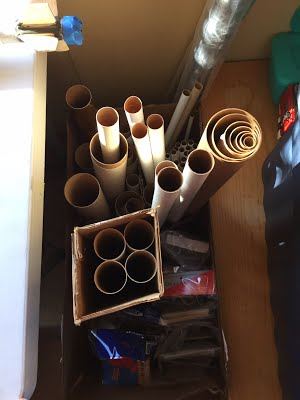 Cardboard body tubes and the ever growing collection of unbuilt models I picked up as a 'bargain' store nicely next to the table in an old shipping box with the top cut off. I tend to store tubes of the same size rubber banded together, although my coupler stock I use for making custom tubes I store nested inside themselves. A word of warning--floods can happen anywhere for the most ridiculous reasons, so always put cardboard boxes up on blocks off the floor; wood blocks or PVC pipe both work well. That laundry machine is half the house away, or that window never leaks, except when it does. You have been warned!
Cardboard body tubes and the ever growing collection of unbuilt models I picked up as a 'bargain' store nicely next to the table in an old shipping box with the top cut off. I tend to store tubes of the same size rubber banded together, although my coupler stock I use for making custom tubes I store nested inside themselves. A word of warning--floods can happen anywhere for the most ridiculous reasons, so always put cardboard boxes up on blocks off the floor; wood blocks or PVC pipe both work well. That laundry machine is half the house away, or that window never leaks, except when it does. You have been warned!
High power models are built and live mostly in the garage, which, due to the bake oven
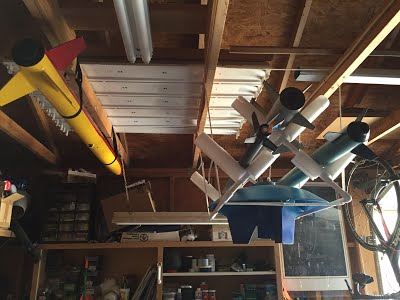 effect in a Tucson garage, means I only work out there in the cooler months or late at night, after the temperature drops below 100 degrees. And due to their size, storage of 4, 6, or 8 foot rockets is a challenge left to the garage rafters. Nylon webbing works well for heavy rockets solo on a rafter, while lighter rockets can store more compactly in a padded PVC A frame hanging from 2 rafters. Both configurations can be slung above head height.
effect in a Tucson garage, means I only work out there in the cooler months or late at night, after the temperature drops below 100 degrees. And due to their size, storage of 4, 6, or 8 foot rockets is a challenge left to the garage rafters. Nylon webbing works well for heavy rockets solo on a rafter, while lighter rockets can store more compactly in a padded PVC A frame hanging from 2 rafters. Both configurations can be slung above head height.
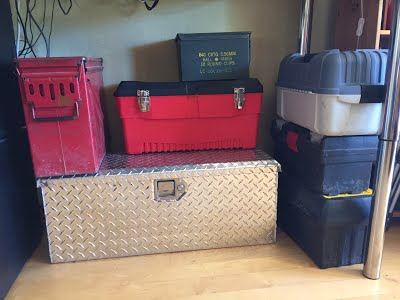
Due to the temperature fluctuations in a Tucson garage, rocket motors can't live in the garage. To store motors safely, they must be in a spark-proof container at least 25 feet from sources of open flame. In our home, that translates to the space under my desk. Black powder motors I store and organize in plastic toolboxes, and I have a tackle box full of my reload casings, brushes, closures, and other reloadable motor paraphernalia.
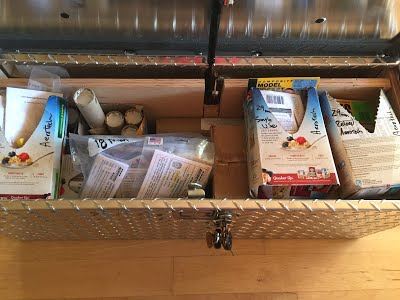
High power motors, however, I store in a lockable steel trunk lined with plywood. I sort them into reused boxes or ziplock bags by manufacturer and diameter. Before each launch, I transfer the motors I may need to ammo boxes for transport.
Then there is the question of where to paint. We are fortunate that we have largely undeveloped desert behind our house, with an easement between our house and the neighbors' yards. this lends itself well to paining, which we accomplish with the help of rebar pounded into the ground. Most rockets get painted vertically with the rebar through the motor mount, although overturned cat litter buckets serve well to hold models horizontally if needed. All this done well away from pavement and any foot traffic.
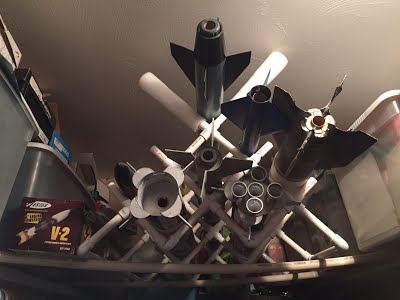
If I were able to change anything about my rocket shop, it would be to have a climate controlled space dedicated to rocketry close enough to the rest of the house that I can keep an eye on what's going on without having to set up and put away rocket projects regularly. Having all the rocketry supplies, tools, and work space in one undisturbed area is a luxury I don't have right now, so I have to get creative with the storage of rocket supplies and completed models. Thankfully, I'm married to a goddess of patience and tolerance, who doesn't seem to mind sharing closet space with a full rack of model rockets and the smell of spent rocket motors. We should all be so lucky! Thank you, Rachel!